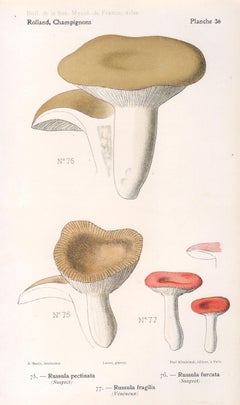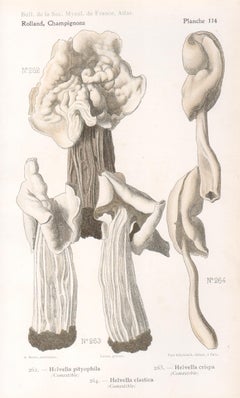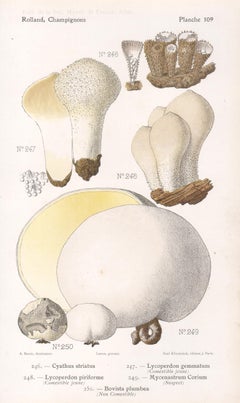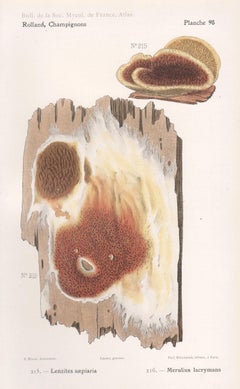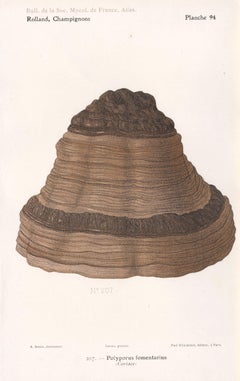Miniature Still-life Prints
to
530
1,737
794
1,032
541
315
Overall Width
to
Overall Height
to
449
361
123
103
36
27
22
21
19
17
9
6
5
3
32
31
31
28
28
109
164
1,003
460
11
6
30
15
72
157
180
126
164
87
99
1,193
345
190
328
246
212
211
181
149
108
90
89
68
63
59
57
56
52
51
47
44
40
38
692
324
309
241
101
126
264
1,047
428
Size: Miniature
Champignons, French antique mushroom fungi chromolithograph, 1910
Located in Melbourne, Victoria
'75. Russula pectinata 76. Russula furcata 77. Russula fragilis'
Antique French mushroom / fungi chromolithograph.
From "Atlas des champignons de France, Suisse et Belgique," an at...
Category
Early 20th Century Naturalistic Still-life Prints
Materials
Lithograph
Champignons, French antique mushroom fungi chromolithograph, 1910
Located in Melbourne, Victoria
'262. Helvella pityophila 263. Helvella crispa 264. Helvella elastica'
Antique French mushroom / fungi chromolithograph.
From "Atlas des champignons de France, Suisse et Belgique,"...
Category
Early 20th Century Naturalistic Still-life Prints
Materials
Lithograph
Champignons, French antique mushroom fungi chromolithograph, 1910
Located in Melbourne, Victoria
'246. Cyathus striatus 247. Lycoperdon gemmatum 248. Lycoperdon piriforme 249. Mycenastrum Corium 250. Bovista plumbea'
Antique French mushroom / fungi chromolithograph.
From "Atla...
Category
Early 20th Century Naturalistic Still-life Prints
Materials
Lithograph
Champignons, French antique mushroom fungi chromolithograph, 1910
Located in Melbourne, Victoria
'215 Lenzites saepiaria 216. Merulius lacrymans'
Antique French mushroom / fungi chromolithograph.
From "Atlas des champignons de France, Suisse et Belgique," an atlas of French, S...
Category
Early 20th Century Naturalistic Still-life Prints
Materials
Lithograph
Champignons, French antique mushroom fungi chromolithograph, 1910
Located in Melbourne, Victoria
'207. Polyporus fomentarius'
Antique French mushroom / fungi chromolithograph.
From "Atlas des champignons de France, Suisse et Belgique," an atlas of French, Swiss, and Belgian fu...
Category
Early 20th Century Naturalistic Still-life Prints
Materials
Lithograph
RAVIOLI DI TONNO MARCO POLO
Located in New York, NY
Decal printed on porcelain plate. Edition of 510. Depiction of a wrapped ravioli.
Category
1960s Modern Still-life Prints
Materials
Porcelain
Seasons 1981 Photo Color Copier Print Photograph Museum Collected Art Xerography
Located in Surfside, FL
SEASONS (1981)
This is for the single print listed here. (not the outside folder or title sheet)
Title: Rocket ship and (toy) soldier. This one is hand signed and dated verso.
Season...
Category
1980s Contemporary Color Photography
Materials
Color
Blumen in Vase
Located in New York, NY
Color woodcut on Japan paper. Signed, numbered 1/30 and inscribed by the artist.
Category
1910s Impressionist Abstract Prints
Materials
Color, Woodcut
Cloud II with Screenprint on Paper by Simon Tozer
By Simon Tozer
Located in Deddington, GB
Cloud II by Simon Tozer [2021]
Cloud 2 is a limited edition screenprint by artist Simon Tozer. This is one of an ongoing series of seascapes and sky images that have clouds as their...
Category
2010s Abstract Landscape Prints
Materials
Screen
Vicky Oldfield, Quiet Beauty, Still Life Art, Affordable Art, Art Online
Located in Deddington, GB
Vicky Oldfield
Quiet Beauty
Limited Edition Collograph Print
Edition of 30
Image Size: H 20cm x W 16cm
Sold Unframed
(Please note that in situ images are purely an indication of how ...
Category
21st Century and Contemporary Contemporary Still-life Prints
Materials
Paper, C Print
Botanical Hand-Colored Engravings, Pair
Located in Astoria, NY
Pair of Botanical Hand-Colored Engravings, 19th century, comprising: Samuel Holden (English, 1800-1860), "Mirabelia Floriabunda", signed and titled in plate and "Cyclogyne Canescens"...
Category
19th Century Naturalistic More Prints
Materials
Paper, Engraving
Cabbage (1/20)
Located in Nashville, TN
Tom White is a New Zealand-based artist investigating artificial intelligence and machine perception. White's artwork examines the Algorithmic Gaze: how machines see, know, and artic...
Category
2010s Contemporary Prints and Multiples
Materials
Screen
TWO BOTTLES, STATE 1
By Tony Cragg
Located in New York, NY
still-life print of 2 plastic bottles
soap ground and spit bite aquatints with aquatint
edition of 25
signed in light pencil with edition number, titl...
Category
1980s Contemporary Still-life Prints
Materials
Aquatint
"4 (Recalculate Your Balance)", silkscreen print, double-sided, cotton rag paper
Located in Toronto, Ontario
"4 (Recalculate Your Bank Balance)", 2018, is a limited-edition silkscreen print, double-sided by Andrew Cornell Robinson. This print is an edi...
Category
21st Century and Contemporary Contemporary Figurative Prints
Materials
Paper, Archival Paper, Color, Screen
Scent of Flowers
Located in Palm Springs, CA
While the images have some resemblance to traditional Japanese Ukiyo-e prints, their sense of whimsy, satire and irony relate more closely to contemporary life and western sensibilit...
Category
2010s Contemporary Still-life Prints
Materials
Intaglio
untitled (Music)
Located in Palm Springs, CA
Originally published as part of artist book Quartet, with essays by Lewis Thomas.
The paper was commissioned for the edition from Twinrocker Papermill. This etching incorporates a variety of graphic techniques, including aquatint, spitbite, drypoint, and hard and soft ground methods. They were printed by Robert Townsend...
Category
1980s Contemporary Still-life Prints
Materials
Etching, Aquatint
$175 Sale Price
41% Off
Levitation XVIII
Located in Palm Springs, CA
Signed and numbered from the edition of 15.
The illusions and reflections in Sietins prints often bring M.C. Escher to mind, but his prints have a distinctive feel all their own. Th...
Category
2010s Contemporary Still-life Prints
Materials
Photogravure
Untitled 65
Located in New York, NY
Cyanotype (Unique)
Signed, titled, and dated in pencil, verso
This artwork is offered by ClampArt, located in New York City.
These cyanotype prints of botanical specimens were made ...
Category
1990s Contemporary Still-life Prints
Materials
Color
Zhiyong Jing Silkscreen Print "Slightly Drunk"
By Zhiyong Jing
Located in Draper, UT
Jing Zhiyong's "Slightly Drunk" is a captivating piece that reflects the artist's unique ability to blend childlike simplicity with adult humor. This limited edition print, created i...
Category
2010s Contemporary Still-life Prints
Materials
Screen
Henri Matisse (After) - Lithograph - Pumpkin and Flowers
Located in Collonge Bellerive, Geneve, CH
after Henri MATISSE (1869-1954)
Lithograph after a drawing of 1941
Printed signature and date
Book plate from Aragon. Henri Matisse: Dessins, Thèmes et Variations : précédés de "...
Category
1940s Modern Figurative Prints
Materials
Lithograph
"Homo" Verne
By Geoffrey Archbold
Located in Fairlawn, OH
"Homo"Verne, (Still Life with wine bottle, wine glass, glass of beer and dice)
Pochoir printed on black textured colored paper, c. 1930
Signed and numbered in white pencil by the art...
Category
1920s American Modern Still-life Prints
Materials
Screen
Hoopoe by Kate Heiss
By Kate Heiss
Located in Deddington, GB
limited_edition
Oil based inks on 300gsm Somerset Velvet Paper
Edition number 50
Image size: H:30 cm x W:30 cm
Complete Size of Unframed Work: H:40 cm x W:40 cm x D:1cm
Sold Unf...
Category
2010s Expressionist Animal Prints
Materials
Handmade Paper, Bromoil
Untitled F24
Located in New York, NY
Cyanotype (Unique)
Signed, titled, and dated in pencil, verso
This artwork is offered by ClampArt, located in New York City.
These cyanotype prints of botanical...
Category
1990s Contemporary Still-life Prints
Materials
Color
Untitled 62
Located in New York, NY
Cyanotype (Unique)
Signed, titled, and dated in pencil, verso
This artwork is offered by ClampArt, located in New York City.
These cyanotype prints of botanical specimens were made by artist Pipo Nguyen-duy in Claude Monet’s garden...
Category
1990s Contemporary Still-life Prints
Materials
Color
Fig-marigold Showy, Mesembryanthem spectabile Plate 396
Located in Columbia, MO
Fig-marigold Showy, Mesembryanthem spectabile Plate 396
1797
Hand-colored etching
Ed. 1st ed.
9 x 5.25 inches
Category
1790s Naturalistic Still-life Prints
Materials
Etching
Gesneria Cooperi, antique botanical red flower engraving
Located in Melbourne, Victoria
Engraving with original hand-colouring. 1834. 230mm by 155mm. From Paxton's 'Magazine of botany and register of flowering plants' by Sir Joseph Paxton.
Category
Mid-19th Century Naturalistic More Prints
Materials
Engraving
Glaucium Phoenicium (Red Horned-Poppy) /// James Sowerby Botanical Flower Plant
Located in Saint Augustine, FL
Artist: James Sowerby (English, 1757-1822)
Title: "Glaucium Phoenicium (Red Horned-Poppy)" (Vol. 7, Plate 1433)
Portfolio: English Botany; or, Coloured Figures of British Plants
Year...
Category
Early 1800s Victorian Still-life Prints
Materials
Watercolor, Engraving, Intaglio
Hanging Mistletoe (Loranthus pendulus), antique botanical plant lithograph
Located in Melbourne, Victoria
'Hanging Mistletoe (Loranthus pendulus)'
Colour lithograph, 1909.
Category
Early 20th Century Naturalistic More Prints
Materials
Lithograph
Apple of Sodom (Solanum - sodomaeum, Linne), antique botanical plant lithograph
Located in Melbourne, Victoria
'Apple of Sodom (Solanum - sodomaeum, Linne)'
Colour lithograph, 1909.
Category
Early 20th Century Naturalistic More Prints
Materials
Lithograph
Fresh Blooms, Vicky Oldfield, Contemporary still life art, Landscape art
Located in Deddington, GB
Fresh Blooms by Vicky Oldfield
Hand signed by the artist
Limited Edition Collograph Print
Edition of 30
Image Size: H 19.5cm x W 15.5cm
Sheet Size: H 35.5cm x W 30.5cm x D 0.1cm
Sol...
Category
21st Century and Contemporary Art Deco Landscape Prints
Materials
Paper, Ink
Matisse, Série M, var. 4 (Duthuit 9), Dessins, Thèmes et variations (after)
Located in Southampton, NY
Lithograph on vélin pur fil paper. Inscription: Signed in the plate and unnumbered, as issued. Good condition. Notes: From the folio, Henri Matisse, Dessins, Thèmes et Variations, 19...
Category
1940s Modern Still-life Prints
Materials
Lithograph
$796 Sale Price
20% Off
Matisse, Série M, var. 5 (Duthuit 9), Dessins, Thèmes et variations (after)
Located in Southampton, NY
Lithograph on vélin pur fil paper. Inscription: Signed in the plate and unnumbered, as issued. Good condition. Notes: From the folio, Henri Matisse, Dessins, Thèmes et Variations, 19...
Category
1940s Modern Still-life Prints
Materials
Lithograph
$796 Sale Price
20% Off
Matisse, Série J, var. 2 (Duthuit 9), Dessins, Thèmes et variations (after)
Located in Southampton, NY
Lithograph on vélin pur fil paper. Inscription: Signed in the plate and unnumbered, as issued. Good condition. Notes: From the folio, Henri Matisse, Dessins, Thèmes et Variations, 19...
Category
1940s Modern Still-life Prints
Materials
Lithograph
$796 Sale Price
20% Off
Matisse, Série J, var. 3 (Duthuit 9), Dessins, Thèmes et variations (after)
Located in Southampton, NY
Lithograph on vélin pur fil paper. Inscription: Signed in the plate and unnumbered, as issued. Good condition. Notes: From the folio, Henri Matisse, Dessins, Thèmes et Variations, 19...
Category
1940s Modern Still-life Prints
Materials
Lithograph
$796 Sale Price
20% Off
Matisse, Série H, var. 10 (Duthuit 9), Dessins, Thèmes et variations (after)
Located in Southampton, NY
Lithograph on vélin pur fil paper. Inscription: Signed in the plate and unnumbered, as issued. Good condition. Notes: From the folio, Henri Matisse, Dessins, Thèmes et Variations, 19...
Category
1940s Modern Still-life Prints
Materials
Lithograph
$796 Sale Price
20% Off
Matisse, Série H, var. 7 (Duthuit 9), Dessins, Thèmes et variations (after)
Located in Southampton, NY
Lithograph on vélin pur fil paper. Inscription: Signed in the plate and unnumbered, as issued. Good condition. Notes: From the folio, Henri Matisse, Dessins, Thèmes et Variations, 19...
Category
1940s Modern Still-life Prints
Materials
Lithograph
$796 Sale Price
20% Off
Matisse, Série H, var. 2 (Duthuit 9), Dessins, Thèmes et variations (after)
Located in Southampton, NY
Lithograph on vélin pur fil paper. Inscription: Signed in the plate and unnumbered, as issued. Good condition. Notes: From the folio, Henri Matisse, Dessins, Thèmes et Variations, 19...
Category
1940s Modern Still-life Prints
Materials
Lithograph
$796 Sale Price
20% Off
Matisse, Série G, var. 5 (Duthuit 9), Dessins, Thèmes et variations (after)
Located in Southampton, NY
Lithograph on vélin pur fil paper. Inscription: Signed in the plate and unnumbered, as issued. Good condition. Notes: From the folio, Henri Matisse, Dessins, Thèmes et Variations, 19...
Category
1940s Modern Still-life Prints
Materials
Lithograph
$796 Sale Price
20% Off
Matisse, Série A, var. 6 (Duthuit 9), Dessins, Thèmes et variations (after)
Located in Southampton, NY
Lithograph on vélin pur fil paper. Inscription: Signed in the plate and unnumbered, as issued. Good condition. Notes: From the folio, Henri Matisse, Dessins, Thèmes et Variations, 19...
Category
1940s Modern Still-life Prints
Materials
Lithograph
$796 Sale Price
20% Off
Wild Mustard (Brassica sinapistrum), antique botanical lithograph
Located in Melbourne, Victoria
'Wild Mustard (Brassica sinapistrum. Boiss.)'
Colour lithograph, 1909.
Category
Early 20th Century Naturalistic More Prints
Materials
Lithograph
Furze (Ulex Europaeus), antique botanical lithograph
Located in Melbourne, Victoria
'Furze (Ulex Europaeus, Linne)'
Colour lithograph, 1909.
Category
Early 20th Century Naturalistic More Prints
Materials
Lithograph
Matisse, Série A, var. 4 (Duthuit 9), Dessins, Thèmes et variations (after)
Located in Southampton, NY
Lithograph on vélin pur fil paper. Inscription: Signed in the plate and unnumbered, as issued. Good condition. Notes: From the folio, Henri Matisse, Dessins, Thèmes et Variations, 19...
Category
1940s Modern Still-life Prints
Materials
Lithograph
$796 Sale Price
20% Off
Bouquet of Flowers
By Cornelis Ploos van Amstel
Located in New York, NY
A supberb impression of this extremely scarce and early color etching after Jan van Huysum. With the artist's ink stamp.
Category
1770s Dutch School Still-life Prints
Materials
Color, Etching
Grapes
Located in New York, NY
A superb, richly-inked impression of this early, very scarce lithograph. Signed and dated in pencil, lower right.
Category
1920s American Modern Still-life Prints
Materials
Lithograph
Jigs
Located in Bozeman, MT
Rooted in observation and fueled by a curiosity about the behavior of objects and handicraft processes, Carly Glovinski makes paintings, sculpture and works on paper that often teeter between representation and abstraction. Letting craft techniques like weaving inform her mark making, her work mimics everyday objects and highlights geometric pattern and structure found in textiles, while exploring the resourceful attitudes associated with domestic craft and rural communities that prioritize placemaking in concert with nature. She received her BFA from Boston University in 2003 and is represented by Morgan Lehman Gallery...
Category
2010s Contemporary More Prints
Materials
Screen
Joan Miro - Playing Dog - Lithograph in Colors
By Joan Miró
Located in Collonge Bellerive, Geneve, CH
Joan Miro - Playing Dog - Lithograph in Colors
Artist: Joan Miro
Composition 7 for the book “Joan Miro” by Jacques Prevert
Editor: Maeght
Year: 1956
Dimensions: 23 x 38 cm
Reference:...
Category
1950s Abstract Abstract Prints
Materials
Lithograph
Late September with Woodcut Print by Robert Greenhalf
Located in Deddington, GB
Late September by Robert Greenhalf [2021]
Late September is a limited edition print by artist Robert Greenhalf. Made using woodcut printing techniques and an organic earthy color sc...
Category
2010s Abstract Animal Prints
Materials
Woodcut
Nature morte au bulbe d'ail
By Mario Avati
Located in Fairlawn, OH
Nature morte au bulbe d'ail
Mezzotint, 1957
Signed, titled & numberred in pencil (see photos)
Edition: 50 (40/50)
Condition: Excellent
Image: 10 7/8 x 11 5/8 inches
Sheet: 14 7/8 x 1...
Category
1950s 85 New Wave Still-life Prints
Materials
Mezzotint
Kate Heiss, Midnight Garden, Floral Print, Limited Edition Print, Affordable Art
By Kate Heiss
Located in Deddington, GB
Midnight Garden By Kate Heiss [2021]
Limited Edition
Oil based inks on 300gsm Somerset Velvet paper
Edition number 50
Image size: H:27 cm x W:27 cm
Complete Size of Unframed Work: H:40 cm x W:40 cm x D:1cm
Sold Unframed
Please note that insitu images are purely an indication of how a piece may look
This circular midnight garden print features a medley of summer blooms. Echinacea, helichrysum, and cosmos are dancing in the moonlight and are visited by a beautiful striped Hawkmoth. This print is cut from 5 individual Lino blocks. Limited Edition of 50 Linocut Print – A relief printing technique where lino is cut, inked and rolled to create an inverse relief print, generating the image as seen.
Kate Heiss is a textile designer and print-maker who has worked with a wide range of fashion brands including Fenchurch, Miss Selfridge and the Japanese fashion designer Michiko Koshino...
Category
21st Century and Contemporary Contemporary Still-life Prints
Materials
Paper, Linocut
Le Sacre Coeur - Color Lithograph - Bernard Buffet
Located in Sint-Truiden, BE
These works were printed in November 1967 by Fernand Mourlot, master lithographer in Paris.
Category
1960s Still-life Prints
Materials
Lithograph
$141 Sale Price
20% Off
Helvella Crispa, Leuba antique mushroom fungi chromolithograph print
Located in Melbourne, Victoria
'1-2 Helvella Crispa 3-6 Peziza Repanda' (White Saddle and Palomino cup)
Antique Swiss mushroom / fungi chromolithograph, lithographed by H Furrer after ...
Category
Late 19th Century Naturalistic Still-life Prints
Materials
Lithograph
Saltshaker and Snail (9/10)
Located in Nashville, TN
Tom White is a New Zealand-based artist investigating artificial intelligence and machine perception. White's artwork examines the Algorithmic Gaze: how machines see, know, and articulate the world. As machine perception becomes more pervasive in our daily lives, the world as seen by computers becomes our dominant reality. White explores this phenomenon in his work.
Collaborating with AI systems, White creates physical abstract prints that are reliably classified by neural networks...
Category
2010s Contemporary Prints and Multiples
Materials
Screen
------- Shining-leaved, Salvia formosa Plate 376
Located in Columbia, MO
—– Shining-leaved, Salvia formosa Plate 376
1797
Hand-colored etching
Ed. 1st ed.
9 x 5.25 inches
Category
1790s Naturalistic Still-life Prints
Materials
Etching
Helen Fay, What’s That?, Penguin Art, Affordable Art, Limited Edition Print
Located in Deddington, GB
What’s That? by Helen Fay [2012]
Limited Edition
Etching , hand printed on Hanemulle etching paper
Edition number edition size 75
Image size: H:21 cm x W:18 cm
Complete Size of Unframed Work: H:45 cm x W:30 cm x D:.15cm
Sold Unframed
Please note that insitu images are purely an indication of how a piece may look
Original Print, hand made and hand printed by the artist. A gentoo penguin, standing wings out, her attention just grabbed by something. The light is just catching her soft chest feathers. The etching captures the tactile softness of the feathers.
Animals have always been at the heart of my work. I find the form, movement and behaviour of the creatures I draw a source of limitless fascination. I love the idea of them watching me, watching them as I draw. I hope my appreciation of the sentience and character of the animals I draw comes across in my work. Over my career I have drawn everything from primates to penguins, dogs, ostriches and even an echidna. These days dogs are my main focus, mostly because I adore dogs but also because they are such an integral part of life. I am delighted by the theory that humans and dogs co evolved, we wouldn’t be what we are without them and vice versa. I try to pare my images down to a balanced simplicity that directs attention to the subject of the picture. I try to balance the subject and the space it occupies, giving each equal importance. Light is hugely important to my work, I imagine my subject in three dimensions as I draw and the light describes the musculature and texture that gives the drawing it’s presence and grounds it in the picture. I aim to capture a pause, a moment where whatever I draw looks like it could wander off or leap up any minute. My influences include Japanese prints, Chinese and Japanese brush drawing and the European artists who were influenced by Japan. I am really excited by composition, by artists like Bonnard and Leon Spilliaert...
Category
21st Century and Contemporary Contemporary Animal Prints
Materials
Paper, Etching
Seasons 1981 Photo Color Copier Print Photograph Museum Collected Art Xerography
Located in Surfside, FL
SEASONS (1981)
This is for the single print listed here. (not the outside folder or title sheet)
Title: Flowers. This one is not hand signed although the rest in the portfolio were. ...
Category
1980s Contemporary Color Photography
Materials
Color
Seasons 1981 Photo Color Copier Print Photograph Museum Collected Art Xerography
Located in Surfside, FL
SEASONS (1981)
This is for the single print listed here. (not the outside folder or title sheet)
Title: Baby Doll. This one is hand signed and dated verso.
Seasons explores the seasons of Man, Woman, Child, Civilization, Nature and Technology. First digital artwork purchased by the Metropolitan Museum.
Date: 1980-1981
Medium: vintage color photocopy print.
“I worked at The Metropolitan Museum in 1981, when they acquired [Lesley’s] SEASONS portfolio.
We knew we wanted it, even though we didn’t have a category for it.” David Kiehl, Curator of Prints and Special Collections The Whitney Museum of American Art, New York City.
Lesley Schiff (born 1951) is an American fine artist. Schiff studied painting at the Art Institute Chicago before developing her signature practice using color laser printers to create images. Her work is included in the collections of the Whitney Museum of American Art, the Mead Art Museum and the Metropolitan Museum of Art and other major museums, corporate and private collections globally. Lesley Schiff revolutionized the photocopier from being an office tool to just another instrument in the artist's arsenal. Rather than addressing the tool in her work, Schiff instead uses the photocopier like a paintbrush to realize her vision. Once a painter, Schiff says: “I never intended to stop painting. I just decided to start painting with a modern tool. Working with the color laser printer keeps you in your culture. It's like America. Plugged in. Electronic. Direct." Painting with light, Schiff's body of work outlines a cycle of life: man, woman, child, civilization, nature, technology. More recent works challenge the viewer to understand the concept of eye-levels and perspectives, reinventing the way we see. Schiff's work was the Metropolitan Museum of Art's first digital acquisition, and most recently, was featured at the Whitney Museum of American Art in "Experiments in Electrostatics".
She uses a color laser printer “like a paintbrush” to create her art. She has said about her work and her tool: “I never intended to stop painting. I just decided to start painting with a modern tool. Working with the color laser printer keeps you in your culture. It's like America. Plugged in. Electronic. Direct—but no matter how hi-tech my tools become, I’m a painter, but instead of painting with oils, I paint with light.
The Whitney Museum will show Lesley Schiff's pioneering SEASONS portfolio in its entirety. Many prominent collections acquired SEASONS as their first digital artwork.
She participated in the Punk Art show in the 1970's. Her work kind of relates to Fluxus and Dada.
Leslie Schiff moved from Chicago to New York in the early 1970s. Much of her art involves collage and the Xerox photocopy machine. Her images are rooted in her personal psyche and have an intuitive meaning that is not always easily understood. In exhibitions, Xerox sheets are combined and displayed decoratively on the wall. Schiff has also created books; and made video and sound tapes. She was included in the seminal New York/New Wave 1981 exhibition show at MoMA PS1 along with Jean-Michel Basquiat, William S.Burroughs, David Byrne, Larry Clark, Crash (John Matos), Ronnie Cutrone, Brian Eno, Nan Goldin, Keith Haring, Ray Johnson, Joseph Kosuth, Robert Mapplethorpe, Kenny Scharf, Steven Sprouse, Andy Warhol and Lawrence Weiner.
She did a “visual biography,” comprised of portraits of Bob Dylan—depicted at different ages, from his 20s to his 60s—illustrations of his lyrics, and images of iconic objects like his sunglasses and harmonica. Schiff collaborated with Matthew Carter...
Category
1980s Contemporary Color Photography
Materials
Color
Stilleben mit Obstschale, Modern Screenprint after Max Oppenheimer
Located in Long Island City, NY
Max Oppenheimer, After, Austrian (1885 - 1954) - Stilleben mit Obstschale, Year: circa 1925, Medium: Screenprint, Edition: Test Print, Image Size: 8 x 11.25 inches, Size: 12.75 ...
Category
1920s Modern Still-life Prints
Materials
Screen
Cabbage (2/20)
Located in Nashville, TN
Tom White is a New Zealand-based artist investigating artificial intelligence and machine perception. White's artwork examines the Algorithmic Gaze: how machines see, know, and artic...
Category
2010s Contemporary Prints and Multiples
Materials
Screen
Saltshaker and Snail (10/10)
Located in Nashville, TN
Tom White is a New Zealand-based artist investigating artificial intelligence and machine perception. White's artwork examines the Algorithmic Gaze: how machines see, know, and artic...
Category
2010s Contemporary Prints and Multiples
Materials
Screen
Power Drill (8/10)
Located in Nashville, TN
Tom White is a New Zealand-based artist investigating artificial intelligence and machine perception. White's artwork examines the Algorithmic Gaze: how machines see, know, and artic...
Category
2010s Contemporary Prints and Multiples
Materials
Screen
Recently Viewed
View AllMore Ways To Browse
Chanel Panama
Charles De Montfort
Charles Martin Powell
Charles West Cope
Chi Omega Vintage
Christer Stromholm
Christian Dior Hawaii
Christine Van Der Cingel
Christoffel Bisschop
Cinzano Vintage Prints
Claude Cambour
Claude Monet Spring In Giverny
Clayton Knight
Clifford Charman
Clifford Russell
Clive Madgwick
Clumber Spaniel Paintings
Clumber Spaniels
